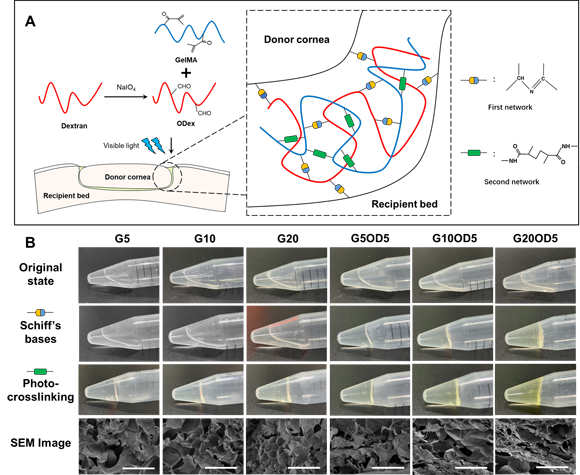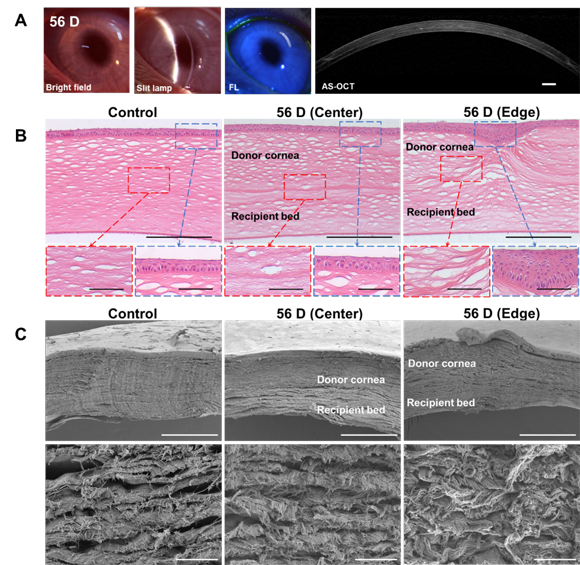Yuan Jin's team from Zhongshan Ophthalmology Center, Sun Yat-sen University developed a photocurable bioadhesive hydrogel for sutureless keratoplasty
Recently Professor Jin Yuan’s group from Zhongshan Ophthalmic Center, Sun Yat-sen University developed a photocurable bioadhesive hydrogel for sutureless keratoplasty, which is composed of gelatin methacryloyl (GelMA) and oxidized dextran (ODex). This bioadhesive hydrogel exhibits high light transmittance, resistance to enzymatic degradation and excellent biocompatibility. It also has higher adhesive strength than commercial adhesives (fibrin glue). These research results were recently published in Bioactive Materials (title: Natural Polymer-Derived Photocurable Bioadhesive Hydrogels for Sutureless Keratoplasty, http:// https://www.sciencedirect.com/science/article/pii/S2452199X21003224). This is another important achievement from Professor Yuan’s group following the "Nano-composite biological drug-loaded contact lens (ACS Nano 2016)" and "Modified biological amniotic membrane (Frontiers in Bioengineering and Biotechnology 2020)".
Pure GelMA hydrogel has poor mechanical strength and adhesive force and cannot replace sutures in corneal transplantation. Therefore, a second interpenetrating network is incorporated into this GelMA-based adhesive hydrogel system to enhance its functionality. The photocrosslinking uses visible light at a wavelength of 405 nm to prevent ocular damage caused by UV light exposure. (Figure 1).

Figure 1 Fabrication and observation of adhesive hydrogels with different ratios of GelMA to ODex.
This adhesive hydrogel has an appropriate gel formation time to ensure that the surgeons have adequate time to carefully adjust the graft in the proper position. Donor corneal grafts could be closely bonded to the recipient corneal bed and remained attached for 56 days by using of this in situ photopolymerized bioadhesive hydrogel. The operated cornea maintains transparent and noninflamed. (Figure 2).

Figure 2 Postoperative observation using slit-lamp microscopy and anterior segment optical coherence tomography (AS-OCT) (A). Representative hematoxylin–eosin (B) and scanning electron microscope (C) images of native rabbit corneas or and the operated rabbit corneas 56 days after sutureless lamellar keratoplasty.
In summary, the team developed a photocurable bioadhesive hydrogel to avoid the need for sutures in keratoplasty. This hydrogel has the characteristics of ideal corneal adhesives, including high light transmittance, resistance to enzymatic degradation and excellent biocompatibility. Moreover, by virtue of the double network structure, the bio-adhesive hydrogel exhibits superior adhesive strength in compared to commercial fibrin glues, and has the capacity to bond the graft to the recipient corneal bed until the wound heals. Following application, this system supports the graft-recipient corneal integration by eventual degradation, and the corneas remain transparent and uninflamed, further indicating its acceptable compatibility. In addition, from the viewpoint of convenience of operation, the photocurable properties of this adhesive hydrogel provide sufficient working time to surgeons for careful planning. Thus, this bioadhesive hydrogel may be an appealing option as a suture substitute in keratoplasty, cornea injury repair and other procedures involving tissue adhesion.
This research has been supported by National Natural Science Foundation of China (81870633) and Guangdong Province Key Field R&D Program (2020B1111150002).
Link:https://www.sciencedirect.com/science/article/pii/S2452199X21003224
